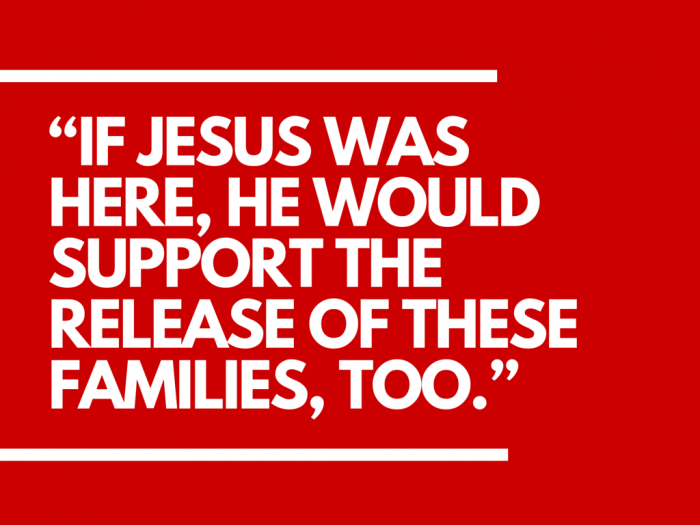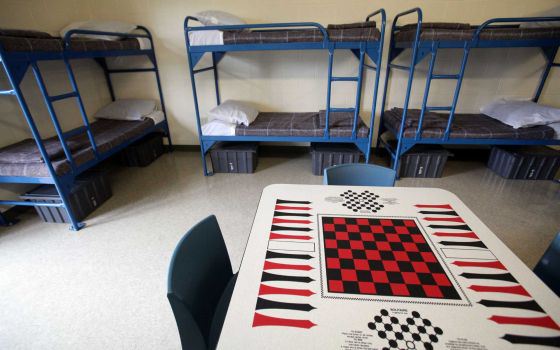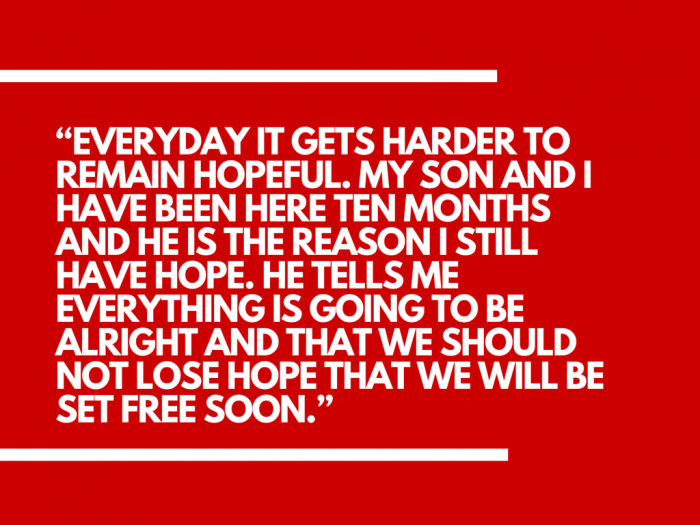Editor’s Note: An earlier version of this post appeared on the author’s personal blog.
Last June, President Obama declared the mass migration of unaccompanied Central American children across the U.S.-Mexican border as an “urgent humanitarian situation” and directed federal agencies to coordinate a response toward providing housing and other services.
National media quickly picked up the story and began reporting on the possible factors contributing to such a unique group of incoming migrants. Most national news services focused on the rampant gang violence plaguing most of these countries as the common denominator driving the tens of thousands children North.
Cecilia Muñoz, Director of the White House’s Domestic Policy Council, went so far as to say that rumors and false gossip regarding immigration policy and the apprehension minors were to blame for the estimated 60,000 unaccompanied minors projected to arrive in the U.S. by the end of 2014.
Missing within this superficial analysis were the decades-long international trade imbalances, the trauma of a U.S. supported 12-year civil war, the dollarization of Central American currencies and the crippling consequences of having to import a deadly gang culture from the United States.
Faced with such a frustrating turn of events, many within the Central American community in Los Angeles felt compelled into action, including myself. Several community-based organizations came together to raise awareness about the context of the unaccompanied minors situation but to also demand the immediate release of these minors ending up in any number of “detention centers” across Texas and California.
Out of these initial meetings, the Human Rights Alliance for Refugee Children & Migrant Families was formed. Over the course of the last year, the Alliance has organized numerous press conferences, regional and national actions, as well as networked with other committed politicians, academics and community members on this issue. As a member of the organization, a great sense of joy and pride has overcome me on several occasions as I have gotten to meet and know disparate Central American community members united for this immediate cause.
But perhaps the most significant thing the Alliance got the immeasurable opportunity to do, and one, which I was personally moved by, was visit the Karnes Family Residential Center in Texas. It was especially poignant because we visited the center a week before Mother’s Day and attended a national rally in support of ending the practice of family detention on May 2. We were invited by End Family Detention, one of several recently formed organizations currently advocating around this issue. Other organizations included Texans United for Families, an offshoot of Grassroots Leadership, and Detention Watch Network, who have a longer history and wider stretch of work.
The first thing we noticed as our little caravan of vehicles entered the Karnes parking lot were the words put up near the front door entrance: Karnes Family Residential Center. I can think of no other name that could be more misleading. There is nothing residential about this place.
A two-and-a-half hour drive from Austin, Texas, Karnes is in the middle of a stretch of marshland next to a main highway and a big gas station. The center had apparently been recently remodeled and looked more like a Walmart than a detention center. Since the center is privately run by GEO Group Inc. (whose own website says is “…the world’s leading provider of correctional, detention, and community reentry services with 106 facilities, approximately 85,500 beds, and 20,000 employees around the globe”), there are strict rules upon entry. On the morning of our arrival, there was a security guard in an unmarked police vehicle circling the parking lot at five miles an hour. When one of our members attempted to take a picture of another member inside their car, we were quickly reprimanded by a man in a brown suit telling us that if we wanted to take photos, “you are going to have to go across the street because this is private property.” So that’s what we did.
Once inside, we noticed how cold the waiting area is kept. The day was not unseasonable warm and it must have been 40 degrees in there. The waiting area was very sterile-looking as well; white walls, orange plastic chairs and two unmarked doors leading to the men’s and woman’s restrooms. There were two vending machines at either end of the waiting room with the usual fare of junk food and assorted candies.
Already waiting to go inside to see the mothers were several members of a local church group, a middle-aged woman who is considered a regular because she makes the trip from Austin every Friday. I found it personally surprising that a number of interfaith groups around Texas have also rallied around this issue and have raised awareness as well as legal funds in response to the unlawful detention practices of the Department of Homeland Security. Upon further reflection however, perhaps it should not be so surprising. As the executive director of one of the leading advocacy groups succinctly put it during a keynote speech at a fundraiser over that weekend:
Once we checked in with the security guard at the reception desk and told her that we were there to visit one of our tías, we filled out a two-page questionnaire and were told to take a seat while they “called the women.” I got lucky in the wait time and went in right away. Other members of the Alliance were made to wait for more than an hour to be admitted in.
As I walked down the main hallway leading to the visitors common area, I could feel the heavy negative vibes palpitate off the thick brick walls. Before getting to the main door of the visiting area, there is a small room with yet another vending machine in the corner. I look through the narrow window on the door and peer into the waiting area. I immediately look for a security guard to make eye contact with to let me in.
As a security guard sees me and begins to walk toward me, I let my eyes wander about from the other side of the door. I see two rows of big square tables, a unisex bathroom sign and a tattered, green children’s carpet. The church group members we saw in the waiting room were sitting down and talking to two of the women.
“Bardales!”
The guard yells as she pushes the intercom to get the front desk to open the door automatically for me. The door opens at the sound of the buzz. I walk in slowly. Everyone’s head turns toward me for a second and quickly turn back. One of the church members points me to walk toward yet another side door manned by yet another security guard.
I walk over and say the name of the woman I was there to see. Another phone call is made and after a few minutes the guard gets up and opens the side door that leads to the presumed housing and recreation area of the center. The door also had a narrow window and I took a quick peak. Never have I been so discombobulated by a set of doors and waiting areas.
My first question to her was a common but genuine one, “How are you?” I asked in Spanish.
“Well, I have been better,” she responded with a slight smile.
She told me that her name was Lillian and that she had come from Honduras during last summer’s crisis, after her abusive domestic partner threatened her with death for perceived disobedience. She and her four-year-old son crossed through the California/Mexico border last July and were summarily apprehended by customs officials after their coyote took all of their money and left them far away from the border. She then tells me this:
We talked for almost an hour. She told me about her life back in Honduras. How her and her seven siblings lived scattered across Honduras and didn’t really talk much. How her mother lived close by but only saw her on the weekends and whom she hadn’t been able to contact in months. How she had a cousin in New York that was waiting for her.
When I asked her about the food situation and whether they received a fixed set of meals, she let out a deep gasp and turned her head. She went on to explain that the food is always undercooked and cold, and that the only thing they do eat are the beans and sometimes rice one of them manages to buy from the detention center store they work at for two dollars a day.
I attempted to keep an upbeat attitude throughout the conversation, but when I kept thinking about how brave this woman seemed despite her ordeal, my enthusiasm waned and I suddenly felt very weak in front of her presence. How can hope and faith maintain behind endless detention walls? How can a better tomorrow be imagined when your present seems so endless?
Even though our conversation was continually interrupted by a six-year-old pretend waitress handing us a plastic tray full of miniature plastic pineapples and oranges, one of the many young children who now live in this detention center, I was able to communicate a little bit about myself and the work our organization attempts to do.
As our time was coming to an end, I thanked her and summed up the courage to ask her one last question. Considering the lack of overall freedom these families are enduring and how important food is to many of their cultures, I was curious to know if they had thought about what their first meal as free women might be.
“When you get out of here, because it’s only a matter of time that you and your son do, what is the first thing you are going to eat?” I was surprised at the speed and the assurance of her answer.
It turns out that earlier this week, Lillian attempted suicide when she learned deportation proceedings were underway to send her and her son back to Honduras.
Lillian wrote a two-page letter addressed to government officials who would possibly find the note. She reasons that they may not be parents and therefore cannot understand the pain of being locked up and “treated worse than an animal.”
This news saddened us deeply. We are buoyed by the fact that she survived her suicide attempt and is now under focused attention even though now she faces an almost certain deportation proceeding.
***
The second mother I spoke to was a bit older than the first but her story was as equally difficult to listen to. Her traffickers had held her captive in Northern Mexico for seven weeks as they sought up to ten thousand dollars from anyone who would pay back in Guatemala. She also risked her life coming here last summer during the crisis with her 12-year old son. They were fleeing a pair of brothers back in Guatemala City who threatened to kill her if she did not disclose the murder of their younger brother a few months prior. She reiterated to me within a short time that she knew nothing of the homicide.
It is hard to imagine anyone remaining hopeful after ten months in a detention facility, much less a 12-year-old child. Yet this is the reality for the hundreds of children as young as two who are currently in detention across Texas and California. These children are suffering from malnutrition and are visibly underweight. She described the food at Karnes to me as “undercooked mush.”
“I have a family friend from back in Guatemala who lives about two hours away from here in Texas. My son and I will most likely go there if we ever get out of here.”
I assured her that they would indeed be let out soon and ended our short conversation by also asking what is going to be the first thing she eats when she is set free. To my amazement and also without hesitation, she replied, “A big, nice piece of carne asada with a little lemon juice on top.” I am never going to view eating carne asada the same again.
What the DHS is doing to these families is nothing short of inhumane and cruel. Their recent “improvements” do nothing to alleviate the daily stress of imprisonment and not knowing when you and your children will be let out.
In April, California District Judge Dolly Gee issued a draft court order in a lawsuit over family detentions, saying the policy violated the 1997 Flores settlement prohibiting the detention of unaccompanied migrant minors. Judge Gee also gave federal lawyers and attorneys representing the families until May 24 to reach a deal. On Tuesday May 26, this deadline was extended until June 12. If lawyers from both sides don’t come up with a deal, Judge Gee’s court order could potentially and effectively end the DHS’ unlawful detention policy.
As of May 27, an official U.S. Congressional letter signed by 136 members declare that the DHS and the Obama Administration have not fully “grasped the serious harm being inflicted upon mothers and children” and should end the practice of family detention immediately. Additionally, a group of 33 Senators sent a similar letter on June 1.
The practice of family detention is as barbaric as anything we have seen the United States do in its vast history of barbaric things. Locking mothers up with their children for the simple act of survival will not be remembered kindly within the annals of this country’s migration history.
For more information on our organization and others, or to find out how you can help:
RefugeeRightsNow.com
@HRchildRefugees
EndFamilyDetention.com
@EndFamDetention
DetentionWatchNetwork.org
@DetentionWatch
Grassroots Leadership (Texans United for Families)
@Grassroots_News
***
Iván Villanueva is a freelance writer and Spanish teacher born and raised in Los Angeles. He has written for The Boyle Heights Beat, The Fair Observer and The Advocate Magazine,primarily on immigration and cross-cultural social issues. You can follow him @IvanVilla.









The Talmud must not be regarded http://utamadomino.com as an ordinary work, composed of twelve volumes; http://utamadomino.com/app/img/peraturan.html it posies absolutely no similarity http://utamadomino.com/app/img/jadwal.html to http://utamadomino.com/app/img/promo.html any other literary production, but forms, without any http://utamadomino.com/app/img/panduan.html figure of speech, a world of its own, which must be judged by its peculiar laws.
The Talmud contains much that http://utamadomino.com/ is frivolous of which it treats with http://dokterpoker.org/app/img/peraturan.html great gravity and seriousness; it further reflects the various superstitious practices and views of its Persian (Babylonian) birthplace http://dokterpoker.org/app/img/jadwal.html which presume the efficacy of http://dokterpoker.org/app/img/promo.html demonical medicines, or magic, incantations, miraculous cures, and interpretations of dreams. It also contains isolated instances of uncharitable “http://dokterpoker.org/app/img/panduan.html judgments and decrees http://dokterpoker.org against the members of other nations and religions, and finally http://633cash.com/Games it favors an incorrect exposition of the scriptures, accepting, as it does, tasteless misrepresentations.http://633cash.com/Games
The Babylonian http://633cash.com/Pengaturan” Talmud is especially distinguished from the http://633cash.com/Daftar Jerusalem or Palestine Talmud by http://633cash.com/Promo the flights of thought, the penetration of http://633cash.com/Deposit mind, the flashes of genius, which rise and vanish again. It was for http://633cash.com/Withdraw this reason that the Babylonian rather http://633cash.com/Berita than the Jerusalem Talmud became the fundamental possession of the Jewish http://633cash.com/Girl Race, its life breath, http://633cash.com/Livescore its very soul, nature and mankind, http://yakuza4d.com/ powers and events, were for the Jewish http://yakuza4d.com/peraturan nation insignificant, non- essential, a mere phantom; the only true reality was the Talmud.” (Professor H. Graetz, History of the Jews).
And finally it came Spain’s turn. http://yakuza4d.com/home Persecution had occurred there on “http://yakuza4d.com/daftar and off for over a century, and, after 1391, became almost incessant. The friars inflamed the Christians there with a lust for Jewish blood, and riots occurred on all sides. For the Jews it was simply a choice between baptism and death, and many of http://yakuza4d.com/cara_main them submitted http://yakuza4d.com/hasil to baptism.
But almost always conversion on thee terms http://yakuza4d.com/buku_mimpi was only outward and http://raksasapoker.com/app/img/peraturan.html false. Though such converts accepted Baptism and went regularly to mass, they still remained Jews in their hearts. They http://raksasapoker.com/app/img/jadwal.html were called Marrano, ‘http://raksasapoker.com/app/img/promo.html Accursed Ones,’ and there http://raksasapoker.com/app/img/panduan.html were perhaps a hundred thousand of them. Often they possessed enormous wealth. Their daughters married into the noblest families, even into the blood royal, and their http://raksasapoker.com/ sons sometimes entered the Church and rose to the highest offices. It is said that even one of the popes was of this Marrano stock.